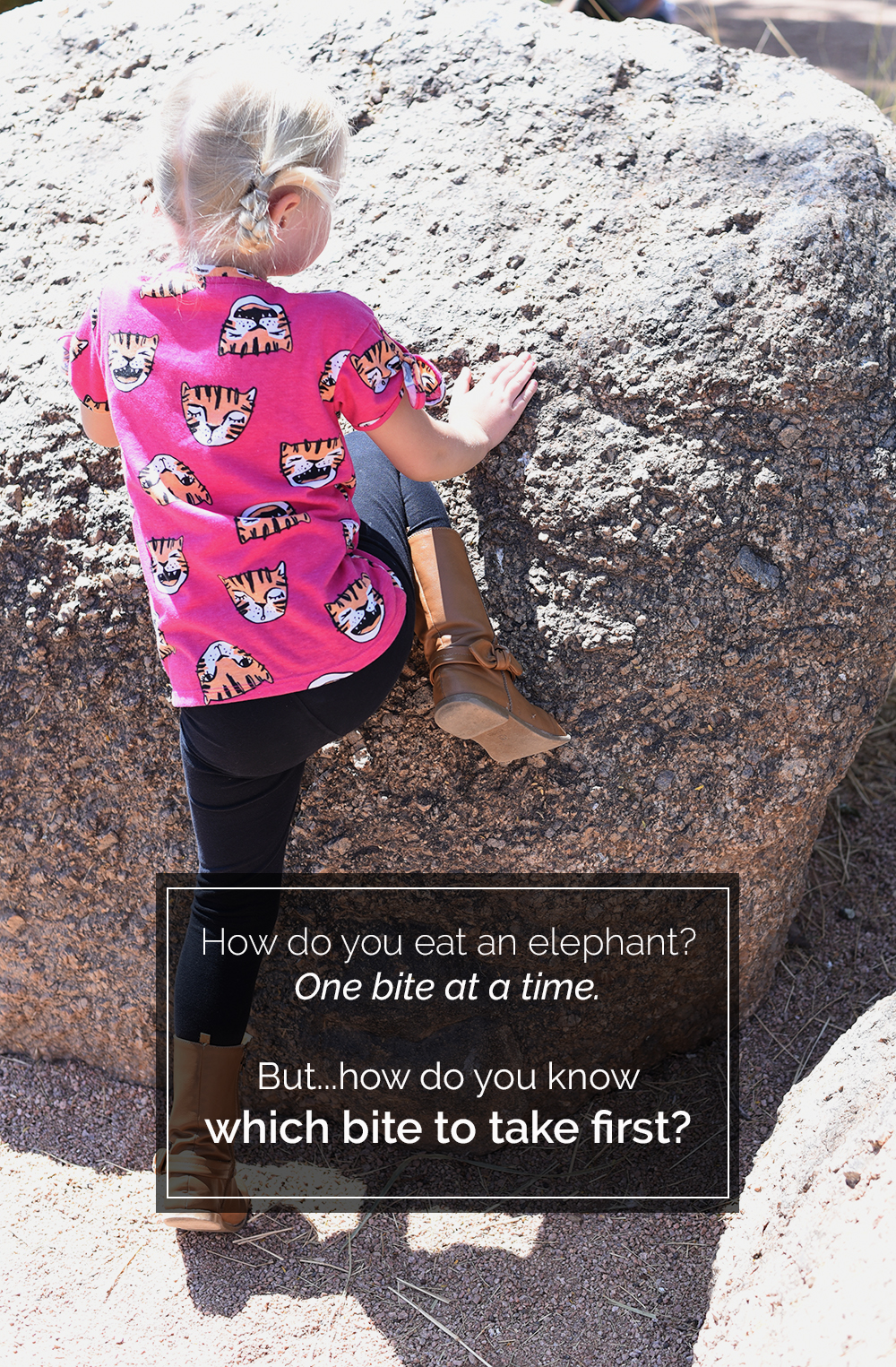Let me premise this post with some delicious irony. Here I am, about to give you advice on figuring out what the next right step for you to take is, but I’ve been putting off writing this for weeks. I knew that writing this post was my “next right step,” at least in regards to ye olde blogge. Instead I let excuses and a little bit plenty of fear get the better of me. I wrote a lot of other things instead, and I put off writing in general for a couple weeks.
But this was the actual next right step. So here I am.
Please know this, first and foremost: it’s okay if you know what your next right step is and you don’t act on it right away. Sometimes you need a minute to gather your courage + your thoughts + your resources first. And sometimes it’s just scary to move forward.
Let’s do it anyway.
***
You know that old adage: “How do you eat an elephant? One bite at a time.” Right?
While I get the gist of it, I’ve always kind of struggled putting it into practice. I mean, which bite do you start with? Like…should I head straight for those giant hocks or maybe nibble an ear first?
(I know it’s meant to be a metaphor and I’m going to continue to make this uncomfortably literal. Dear vegans + elephant fans: I’m so so sorry.)
That’s the thing about massive goals + projects + any kind of major undertaking. THEY’RE MASSIVE. There’s just SO MUCH to do that it’s really easy to look at it and think, “Welp. That’s a lot. Maybe I’ll go rewatch The Office and come back when it shrinks a bit.”
Except the Elephant never does shrink. It stays massive, and sometimes when you let it sit for too long, it gets even bigger. We all know this, either instinctively or from experience. We also know that if we break it down into (metaphorical) bite-sized pieces, it will be much easier.
What we don’t always know is how to do that. Sometimes, even though you know it’s a necessary part of the process, breaking a task down into more manageable parts feels unmanageable.
Here’s what I do to determine my next right step.
1. Reconnect with your priorities.
Are you absolutely certain this goal/project/whatever (I’m just gonna call it an Elephant from now on, okay?) is in line with what you value most?
Por ejemplo: I set a goal this year to go on at least one family vacation. Didn’t matter where we went or how we got there, I just wanted to go together—just me + David + the kids—to some place we could all enjoy. Because I really value quality time with my family, this goal makes sense. Getting out of town would ensure that there are fewer things to distract us from each other, we’d be making memories together, and hopefully we’d come home feeling closer to one another than when we left. Bonus: I also value visiting new, beautiful places!
(Side note: If I decided to plan a family vacation because I value relaxation, I would be a fool. Traveling with children is NOT relaxing. It is, in my opinion, totally worth the effort though.)
So start there. Why do you even want to eat this particular Elephant? Does doing so align with your priorities? If not, maybe finding a different Elephant to pursue is your next right step. If so, let’s move on to…
2. Figure out what you don’t know.
I think that’s the scariest part of dealing with any Elephant: there’s just so much you don’t know going into it.
But you know what? It’s really okay not to know. At one point you didn’t know your ABC’s, so learning to read felt like a BIG DEAL…and now look at you! We all start out not knowing, well, anything. And we learn as we go. The stakes get higher and the lessons get bigger, but it’s all just part of being a person. The not knowing AND the learning.
In my example above, I didn’t know where we would go for our family vacation, when, how we’d get there, etc. My goal was pretty nebulous, and fleshing it out was my next right step. I realize that’s a really basic example, though, so let’s look at some tougher Elephants I’ve either considered or actually tackled.
Write a Book: I don’t know how to get published, if I need an agent, how to find one if I do, etc. Heck, in my case I don’t even know how to write a book. I’ve only ever written essays and blog posts, and from what I hear a book is a very different kind of beast.
By a House: Before I actually did it, I didn’t know what my budget should be, how to find a lender, what kind of down payment I would need, where to find a good realtor, how much I would have to pay them, how to make an offer, what escrow is, how long the process would take, etc. It was daunting!
Remodel a Bathroom: Still learning on this one, but when we started I didn’t know what I wanted the end result to look like, what our budget should be, how to completely demolish the room, who to hire for drywall (because that’s the WORST), how to install tile, where to order fixtures, etc.
Just take a minute and brainstorm aaaalllll the things you don’t know about your Elephant.
3. Put things in order.
Once you’ve written down what you don’t know, you might see a rough timeline of action items begin to emerge. Not everything will fit neatly in order, but there will definitely be a few items that do.
For example, to plan a family vacation, I need to figure out where to go before I decide how to get there. Or maybe the budget or the time frame will come first, as they could influence the where. Then where we’ll stay, how we’ll spend our time, and all the rest will follow.
If I’m writing a book, I should probably actually write a book before worrying too much about agents or publishers.
When buying a house, identifying a budget should probably be number one. Then maybe finding a realtor, since they know the answers to a lot of the questions you’ll have down the road.
And, now that we’re three months into a bathroom remodel, I’ve learned an ideal timeline would be to set a budget first, followed closely by choosing what you want it to look like, picking fixtures + finishes, and actually ordering them. We shouldn’t have done any work until we had made ALL the decisions.
You may even find it useful to work backwards. Like that book If You Give a Mouse a Cookie but in reverse. If you want to end with Z, first you’ll need to do Y, and before you can do Y, you’ll need to X, and so forth until you get to the first thing that needs to be done.
4. Break down the first thing.
You’ve looked at your Elephant and written down all the things you don’t know about how to eat it. You’ve put those things in a loose chronological order. Now take item #1 and break it into smaller chunks.
These will be the tiny bites, the little things you can do that will eventually lead to bigger decisions + greater action. They may be action items like “find bathroom inspiration on Pinterest” or “look for inexpensive flights out of Phoenix” or “call a friend who just bought a house and ask for suggestions.”
Focus on just that one thing you don’t know and learn everything you can about it. Crack it open piece by piece until it makes sense, you’ve made some decisions, and (sometimes surprisingly!) you’ve made progress.
However…
5. Don’t get stuck in the minutiae.
These tiny bites are where it’s easy to get stuck. Never forget, you need to be constantly looking toward your next right thing.
So if today’s right thing is to research plane tickets, tomorrow’s might be to discuss your findings with your spouse and choose one. If today’s right thing is asking for realtor recommendations on Facebook, tomorrow’s might be calling one of the people your friends recommended and making an appointment. If today you found floor tile you like, tomorrow you can measure square footage to see how much you’ll need.
Don’t spend too much time on research or analysis. Learning is good + necessary, but it’s not helping you if you don’t use new information to move forward. Each step will likely lead naturally to a next right step. Take it.
And if you find you’ve reached a stopping point?
6. Pick something else on your list to tackle.
It only took two months, but I finally finished the grout in our bathroom. (I know. Slowest project ever.) Logically, my next right step is to caulk and seal everything in the shower area.
After that, though, we could do a lot of things. Work on the vanity, or install lights, or hook up plumbing, or sand + paint the walls. We could easily stall out and get overwhelmed again by the scope of the project. The Elephant has gotten smaller, but it’s still pretty huge.
It really doesn’t matter what we do next, though. What matters is that we pick something and do it.
Now I want to pause here, because this is really important.
So far I’ve only talked about proactive Elephants. Goals + projects + things you actually want to do.
What if you’re facing a reactive Elephant? You’ve been diagnosed with cancer. A dear friend passes away unexpectedly. Your home is destroyed in a natural disaster. Your child is born with a disability. These are things you can’t control, that you didn’t choose, but that still require you to take action.
You need to treat the cancer. Process your grief. Rebuild. Learn what moving forward will look like for you + your family.
And in these situations, might I suggest that your next right step is to breathe.
No matter where you are in the process of dealing with your Elephant, take a moment to breathe.
Sometimes your next right step will be as simple as getting out of bed in the morning. That’s okay. Start there. The rest will come eventually.
And when you are ready, go through the list again.
1. Reconnect with your priorities.
2. Figure out what you don’t know.
3. Put things in order.
4. Break down the first thing.
5. Don’t get stuck in the minutiae.
6. Pick something else on your list to tackle.
and
7. Take care of yourself.
Often we get so wrapped up in eating our Elephants—both proactive + reactive—that we forget to do some of the most basic things. Like sleeping enough. Eating well. Connecting with people we love. Having a good cry. Going outside. Pausing to give thanks.
Things that fill you up + make you feel whole need to be part of your to-do list. Not so you can procrastinate or escape reality, but so you can show up as your best self when you get back to your Elephant.
Because the Elephant isn’t the important thing. You are.
Achieving goals is pointless if those goals aren’t helping you be a better version of yourself. New projects are fun, but they can quickly become problems if they take you away from what really matters to you. Processing calamities should help you move forward in healthy ways.
Whatever your next right step is, however tiny, it should be leading you toward the person you want to be.
Good luck, my friends. I know you can do this.
Some great resources on getting inspired to identify + take your next right step:
Mindly app: a great way for visually breaking down Elephants into smaller bites. You can create up to three mind maps for free; the upgrade (which I have purchased with no regrets) is around $6. I use it to organize things I’m studying, prioritize blog projects, plan trips, and more.
3 in 30 Takeaways for Moms podcast Episode 14 “Getting Out of Overwhelm”: relevant for everyone, not just moms! I liked her suggestions so much that I sat David down the night after I listened to this episode and we both made massive lists of all the things on our plates. It was weirdly therapeutic, and continues to be helpful as I choose my next right step each day.
How to Set Goals Like a Normal Person from The Lazy Genius Collective: “Any movement is good movement. Every small step keeps us in the purposeful direction we intentionally chose.” Kendra makes everything so simple. If you’re not already a Lazy Genius fan, this will surely win you over.
The Next Right Thing podcast by Emily P. Freeman: short episodes with thought-provoking stories and a wise perspective, all designed to help you “do the next right thing, in love.” Heads up: she incorporates Christian themes, scriptures, and prayer, but even if that’s not your jam, her voice is soothing and her words are lovely.
Let me know if you have any other resources that help you choose your next right step and I’ll update this list!






Leave a Reply